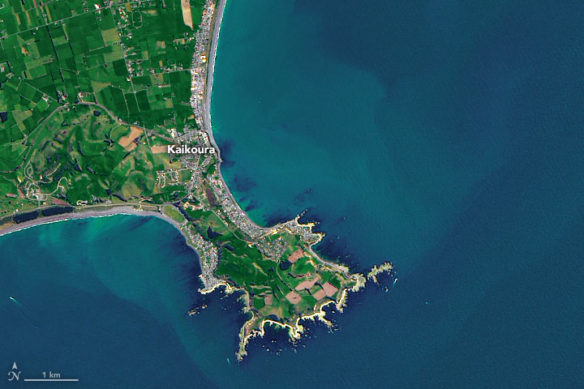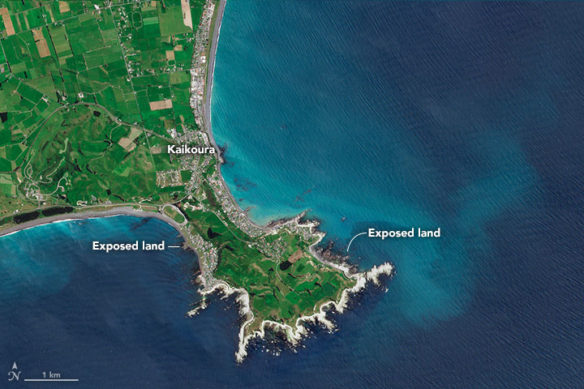
Acquired October 12, 2016.
NASA Earth Observatory images by Joshua Stevens, using Landsat data from the U.S. Geological Survey and Sentinel data from the European Space Agency.

Acquired November 25, 2016.
By Adam Voiland, NASA / Earth Observatory;
On November 13, 2016, a powerful earthquake jolted the northeastern coast of New Zealand’s South Island. The 7.8 magnitude quake lifted the seabed by 0.5 to 2 meters (2 to 7 feet) along a 20-kilometer stretch of the Kaikoura coast. In one area, the uplift was a remarkable 5.5 meters (18 feet).
The sudden shifting of such a huge quantity of rock produced some unusual sights. From above, satellites captured an image of a thin swath of newly exposed land ringing the Kaikoura Peninsula and other parts of South Island.
On November 25, 2016, a multispectral imager on the European Space Agency’s Sentinel 2 satellite captured an image (second) of the newly exposed land near Kaikoura. For comparison, the first image—acquired by the Operational Land Imager (OLI) on Landsat 8—shows the same area on October 12, 2016. The tidal water level was approximately the same in both cases.
On the ground, scientists have encountered some unusual sights as they surveyed the new land by foot and helicopter. Seaweed littered the newly exposed slabs of rock and coral reef. Crayfish, sea snails, and other marine life were left stranded well above the high tide level.
People living near the Kaikoura coast were struck by the sounds that accompanied the quake as well as the sights. “Locals here described not the earthquake noise but the noise of water running off the top of this uplifted platform,” said geologist Kelvin Berryman in a GNS Science video. “They said that the noise was just horrendous.”
There is precedent for uplift of this sort in New Zealand. In 1931, a magnitude 7.8 earthquake at Hawkes Bay raised land around the city of Napier by 1 to 2 meters above sea level. In 1855, a magnitude 8.2 earthquake raised much of Wellington by the same amount. In some cases, new coastal land has proven quite useful. For instance, land that used to be an estuary now provides space for Napier airport.
Most likely, the new land along the Kaikoura coast is there to stay. While beaches raised by earthquakes occasionally sink back down gradually or get pushed down by other earthquakes, the New Zealand coast is full of historical examples of earthquake uplifted land staying put for hundreds to thousands of years, according to a blog post from the New Zealand hazards monitoring organization GeoNet.
Original Article And Learn More, NASA / Earth Observatory (12-03-2016)
RNew Zealand earthquake so strong it lifted sea floor 2 meters, Video, CNN (11-18-2016)









